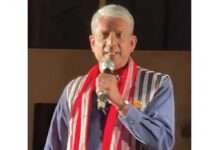[ Nani Bath ]
During the colonial period, the tribal communities of Arunachal Pradesh were broadly categorized as the Abor, the Aka, the Apa Tanang, the Bhutia, the Dafla, the Miri, the Mishmi, the Singpho, the Khamti, and the Naga.
The word ‘Abor’, Assamese in origin, means independent and one who would not submit or owe allegiance to anyone. Since the ‘Abors’ themselves did not like the name, it was changed to Adi (‘Hillman’ or ‘Highlander’). Butler (1847) explains, “Abor is derived from the Assamese word boree, friendly; aboree, unfriendly.”
In a broader sense, however, there are studies which indicate that ‘Abor’ applies to all the independent tribes on both sides of the Assam valley (Dafla Hills, Abor Hills and Naga Hills). Waddell (1901) notes that the name ‘Abor’ is “applied by the Assamese generally to all independent tribes on both sides of the valley, including the Naga tribes to the south of Sibsagar.”
We also find references of ‘Doba Abors’, the present-day Galos, ‘Abor Dufflahs’, ‘Miri-Abors’, ‘Silung Abors’ and ‘Tagen Abors’. With regard to ‘Abor Nagas,’ we find a reference of it in Aitchison’s Treaties, ‘Bori’ or ‘tame’ Nagas and ‘Abori’ or ‘wild’ Nagas, who rarely come in contact with the plains.
The Akas (meaning ‘painted’), officially known as Hrusso, were divided into two groups: First, the ‘Hazari-Khawa’ (eaters at a thousand hearts), also called ‘Kutsuns’, are the Akas of Jameri. Second, the ‘Kapachors’, the ‘Kovatsun’ Akas, who inhabit Buragaon, are generally understood as ‘cotton thief’. Mackenzie (1884) explains the actual meaning, “who lurk amid the cotton plants.” The Akas used to attack the Assamese villages stealthily when the cotton plants were large enough to protect them from view.
The Apatanis, who call themselves Tanw, have accepted the name of the community as ‘Apatani’ (originally Apa Tani), which was actually coined by a colonial anthropologist and writer, CVF Haimendorf in 1944-45. In colonial literatures, they are referred to as ‘Apa Tanang’, ‘Apa Tanang Abor’, ‘Apa Tanang Dafla’, ‘Tenae’, and ‘Anka Miri’. ‘Apa’ is a prefix to a male name when one calls a person affectionately.
The Monpas and Sherdukpens were classified as: (i) ‘Thibetan Bhutia/Kuriapara Bhutia.’ (ii) ‘Charduar Bhutia’ and (iii) ‘Thebangeah Bhutia.’ The first group was under ‘Sat Rajas’ of Kuriapara Duar, who were subordinate to Towang Deb Raja. They are the Monpas of Tawang. The second group is the Sherdukpens, who were called as ‘Rooprai Gawn’ (Rupa) and ‘Sher Ganw’ (Shergaon) Bhutias, who were independent of Towang, having ‘Sath Rajas’ as their chiefs. The ‘Thebangeah Bhutias’ are the Monpas of Thembang, the Tembang Bapus (Khochilu, Dirkhipa, Sherchokpa, Atajaipu). In subsequent writings, the word ‘Momba’ was used, including in the Constitution (Scheduled Tribes) Order, substituted by ‘Monpa’ in 2021. The word ‘Monhpa’ was recorded in 1907.
In colonial writings, the word ‘Miri’ was used for different categories of people: Miris of the hills, and the plain Miris. The plain Miris, who, in contemporary usage, are called Mishings, acted as the go-betweens the hill tribes and the inhabitants of the plains. There are ‘Ghasis’ and ‘Ghyghasis’ on the left bank of the Subansiri, who were known as ‘Miri’. Dalton places ‘Sarak Miris’, ‘Panibotia Miris’ (users of the land paths) and ‘Tarbatia Miris’ (users of the river routes) as branches of the ‘Hill Miris’. In post-colonial discourses and usages, the word ‘Hill Miri’ came to denote the Nyishis of the present Kamle district, although no official notification has ever been issued to the effect.
Captain Duff wrote in 1912 that the name ‘Miri’ is “unsatisfactory and inclined to be misleading,” as the “true name of the tribes and clans of the Kamla valley is Nisi.” WB. Hore (1913) was more categorical in discarding the term ‘Hill Miri’. He maintains that “The tribes are so like Daplas that it would not be incorrect to call them in future, Eastern Daphlas, or Subansiri Daphlas.” Since the Miri (Mishing) had migrated from the Siang, and not the Subansiri valley, the name ‘Hill Miri’ is “erroneous and misleading,” he adds.
In his book Frontiers (1932), George Dunbar narrates an incident and makes a reference to his friends in Beni, “whom we call Hill Miris, but who really are Daflas.” According to Haimendorf, to describe the ‘Hill Miri’ as a separate ‘tribe’ would be “unjustified.” BK Shukla (1964) states that “Hill Miris refer to each other among themselves as Nisi.”
I have not come across any colonial writings that explain the word ‘Dafla/Daphla/Duphla’. The census report of 1881 says that “the origin and meaning of the name Daphla are not known. As pronounced in Lakhimpur, it would be written Domphila. They call themselves Niso or Nising.” However, Haimendorf (1950) writes that “The Assamese term Dafla, like the term Abor, seems to have originally meant ‘wild man’ or ‘barbarian’.” The ‘Daflas’ on the border of Durrang (Darrang) were generally called ‘Paschim’ or Western Duphlas; and those on the border of North Luckimpore, ‘Tagin Duphlas’. The ‘Western Daflas’ were also known as ‘Yanno Dafla’.
By the Constitution (Scheduled Tribes) Order (Amendment) Act, 2008, the name Nyishi was substituted for ‘Dafla’. Since the Ligu Declaration Day, 19 December, 1998, the ‘Hill Miris’ (the Nyishis of Kamle district) have affirmed themselves “to adopt socially and traditionally the authentic tribe nomenclature of Nyishi for all times.”
Mishmi, according to the adviser to the governor (1946), is an “Assamese word of unknown derivation.” Mackenzie has identified various Mishmis clans, which we call as sub-tribes. First, to the north of Sadiya, the ‘Chulikata’ (cropped-hair). Second, ‘Mezho’ clans are found in the Digaru river westward, and on both sides of the Brahmaputra, reaching up the frontier of Tibet. The third is the ‘Tain’ or ‘Digaru’. Fourth, the ‘Maro’, are “those to the south of the Brahmaputra whose settlements are scattered and mixed up with Khamtis and Singpho villages.” We also find reference of ‘Bebejiya’ Mishmis, who actually are the Idus from Ithu valley (Hunli, Desali), and who speak Mithu dialect. Constitutionally, at present, the Mishmis are classified as Kaman (Miju Mishmi), Idu (Mishmi), and Taraon (Digaru Mishmi). The name ‘Naga Misimi’ is found referred in the Ahom Burunji.
The Tangsa, Nocte, Wangchoo and Tutsa were clubbed in the general term ‘Nagas.’ Alexander Mackenzie (1884) divides the Nagas into two groups: ‘the Patkoi Nagas’ and ‘The Seebsagugor Nagas.’ Under the ‘Seebsagugor’ (Sibsagar) group, the ‘Namsangisa’, the ‘Bordwarias’, the ‘Panidwarias’, ‘Banferas’, etc, are included. In some administrative reports, these communities are mentioned as ‘Nagas of the eastern region’ or ‘Eastern Naga.’ The Ahoms used to call them the ‘Nagas.’ It is evident from the grant of land to them, called ‘Naga Khats’.
According to Parul Dutta, ‘Nocte’ means one “who lives in a village” (Noc, village; te, the people). It is reported that the names ‘Singpho’ (meaning, ‘person’) and Tangsa (‘Tang’ = mountain, and ‘sa’= person) were coined by Bipin Borgohain, who served in the Tirap Frontier Tract as the political officer (1950-57). Waddel (1901) writes that the proper tribal name of ‘Singpho’ is ‘Ching-po,’ where the ‘o’ has the sound of the ‘aw’ in ‘law.’ The word Singpho, Singfo, Chingpaw, Jinghpaw, etc, according to E Leach (1964), is a category applied to themselves by the people who speak the Jinghpaw language.
There is also a reference of ‘Rangpang Naga’. Political officer for Rangfang area was also created. Elwin (1957), however, writes that “in actual fact no such tribe exists.”
On the origin of the word Khamti, J Rondo (2018) presumes two different versions: (i) a country full of gold (Kham, gold; ti, place). (ii) A royal title given to some princely class. It is also variously spelt as Kanti, Kansi, Khampti, Hkamti, etc, which appears to be have been originally a title associated with the royal family of Mogaung. Mogaung was once one of the influential Shan states of Upper Burma. UN Gohain (1950) adds another meaning to it, “to adhere to or stick to a place (Kham, to adhere or stick to; ti, place).
The word ‘Wancho’ is not found defined in any of the existing literature within my knowledge. The oral history of the community, too, does not narrate the word ‘Wancho’.
The proper nouns do undergo change when used by a person unfamiliar with the dialect of the community. In 1964, the Galo people and students represented, saying that the correct name of their tribe should be Galo, and the word ‘Along’ should be Alo. PN Luthra, adviser to the governor of Assam, writes that “Galong, Along, etc, came into being because of the Minyong interpreters…. Minyong language has a tradition of using the letters ‘ng’ at the end of some of their words.” Likewise, it is possible that the word ‘Apa Tanang’ came into being because of Nyishi or Mishmi interpreters, who might have found it difficult to pronounce ‘Tanw’ (w = inverted M of IPA symbol).
There are certain names, ‘Kibitoo/Kibithu’, ‘Chowkham’, ‘Sela’, ‘Apatani/Apa Tani’, ‘Hapoli’, ‘Tezu’, though distorted, but are accepted by the indigenous communities.
For example, the name ‘Hapoli’, which actually should have been ‘Ha/Hao-Polyang’, is officially recognised and popularly accepted by the Apatanis. The name ‘Tezu’ became a popular usage because of its long association in the minds of the Mishmis. The political officer, Lohit Frontier Division (1965) writes that, if the Mishmi method of name-giving was rigidly followed, the name of Tezu would have to be changed to ‘Tezab-mla’, “because this is a settlement situated by the banks of a stream called Tezab.” Similarly, Chowkham should have been ‘Chongkham’ (Chong means monastery and Kham means gold), and Kibithoo/Kibithu as ‘Kibithang’ (Kibi means pleasant and Thang means meadow). Since the Monpas of Dirang and Tawang pronounce the mountain pass as Tze-la, the name Sela, we find in official records is actually wrong. There are references of Tze-la in archival records.
Perusal of archival records and discussions with village elders across the state have given me to understand that seemingly derogatory names used during colonial administration may not have been intentional. It could have been because of misinterpretation, lack of proper communication, ‘innocent’ representation, and the problem of pronunciation.
However, I find the Tibetan word ‘Lhopa’/’Loba’ for the Abotani communities (both India and Tibetan side), meaning ‘uncultured’, certainly derogatory. The recent renaming of Kimin to ‘Bilgarh’ by ITBP looks political. Communist China’s giving ‘new names’ to certain places of Arunachal Pradesh is intended to put diplomatic pressure on India. (Professor Bath is a faculty member in Rajiv Gandhi University. He can be contacted at nanibath@rediffmail.com)


